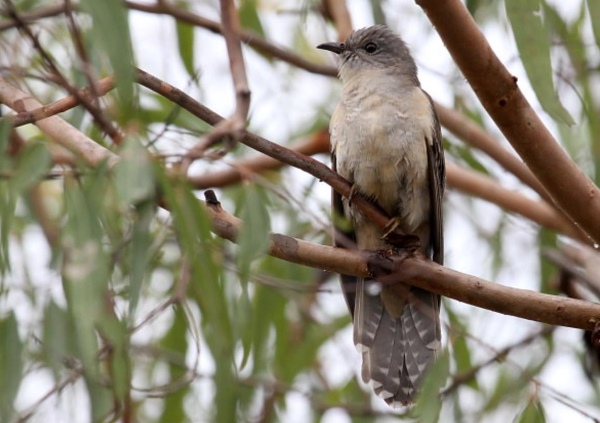The brush cuckoo call is a far-carrying, descending chromatic sequence of 6–8 melodic whistled notes. Also shrill repeated rising phrases by displaying males’ Where’s the tea’, becoming hysterical towards the end. The tone of its call is recognizable from bush sounds in Australia and Indonesia. Note that brush cuckoos have other, less frequent vocalizations in addition to these two most prevalent sounds. Therefore, a brush cuckoo call is a sequence of melodious whistles that are progressively lower in pitch and somewhat slurred. Several of the YouTube videos you cited feature this call. Some bird lovers think its call is mournful. Here, listen to the call.

The other facts about the brush cuckoo are below!
Habitat: It is reported to live in a variety of habitats in Australia, such as plantations, mangrove forests, secondary forests, and rainforests and their boundaries. Brush cuckoo is widespread from southeast Asia to Australasia. The Brush Cuckoo is a rather sedentary bird through most of its range. Across northern Australia, it is present year-round, although it is more vocal and noticeable during summer breeding. In the southeast, however, the endemic race there is migratory, arriving in August–September and leaving in April-May to winter as far north as the New Guinea region. Everywhere, it lives within tangled forest edges, rainforest fringe, galleries of monsoon scrub, and thickets lining streams.
Identification: The male brush cuckoo’s upper parts are olive-brown with a greenish sheen. The head, mantle, chin, and throat are leaden grey. The underparts are grey-brown to rufous fawn. The wings are browner, faintly mottled, and barred brown. Also, the underwing has a broad cream-white stripe. The tail is slate brown with a purple tinge. The webs are notched white, most strongly on the inner edge. The eyes are chestnut-dark brown. The eye-ring is paler. The bill is black-brown. The lower mandible is olive or dull yellow with a darker tip; the mouth is deep orange. The feet are orange-yellow to olive. And the claws are a bit darker.
The female cuckoo is a little duller, and the underparts are sometimes faintly mottled. Eye brown-olive. Mouth: yellow-light orange. Feet greenish-grey.
The immature bird mottled dark brown and deep buff on the upper parts, and dark brown and pale buff on the underparts. Molts into immature plumage of brown and buff barred upper parts and white and brown-barred underparts. Later, the upperparts, wing, and tail become similar to adults, but the head remains dark brown with buff markings; the underside becomes replaced by a leaden grey breast, washed russet.
Behavior: Although it has been recorded as parasitizing about 50 species, the brush cuckoo lays mainly in the open, cup-shaped nests of flycatchers, fantails, and red-breasted robins in the southeast, and in the deeper domes of brown-backed and bar-breasted honeyeaters across the north. Its eggs commonly resemble those of its chosen host. Brush Cuckoos are commonly solitary, only gathering in brief, noisy communal displays of up to eight birds at times when breeding. Males advertise themselves and their loosely held territories with long and sometimes excited calls, carrying on into the night. In courtship and display, males feed females and chase with their darting but graceful pointed-wing flight.
Nesting and Breeding: Brush cuckoo nesting and breeding occur in October-February in the south and for the greater part of the year in the north. Parasitic.
Eggs: The eggs of brush cuckoos are polymorphic, meaning that the females lay different kinds of eggs for different hosts. Lays different egg types (with intermediates) similar to the host’s: Leaden Flycatcher type-creamy-white to white and speckled, spotted, or blotched olive-brown with underlying tones of lavender forming a zonal ring at the larger end; rounded to rounded oval (most regions). Grey-Fantail type pale-cream to cream buff, spotted and speckled with darker shades of brown, olive-brown, and lavender to form a zonal ring at the larger end (in south and east); rounded to rounded-oval. Brown-backed Honeyeater type: white, sparingly spotted or speckled at the larger end with black-brown and underlying tones of dark mauve-lavender (in the northeast); oval to elongate-oval. The Rhipidura type is similar to the Grey Fantail type but tinged grey-green (in the northwest). 16-20 x 17 x 12-16 mm. A single female brush cuckoo may lay two to four eggs in a single season, each in a separate nest. The incubation period is about 12–14 days. The young fled in 16–17 days.
Distribution: Brush cuckoo is found in the coastal and subcoastal Kimberley’s and Arnhem Land to the Cape York Peninsula, and coastal eastern regions inland to the Great Dividing Range and south to the Dandenong Ranges, Victoria. Also, it can be found on the Malay Peninsula, from Indonesia to the Solomon Islands.
Races: There are about 18 races. However, only two races exist in Australia: one small, pale, and sedentary across the north; the other larger, dark, and migratory along the central and southeast coast.
Diet: Brush cuckoos feed on insects and caterpillars among branches by perch-and-pounce sallying; only during the wet season in the north does it venture out much into open woodland.
Family: The brush cuckoo (Cacomantis variolosus) is a member of the cuckoo family Cuculidae in the genus Cacomantis.
Migration: In northern Melanesia and New Guinea, it might move locally. It is migratory in the southern portion of its range in Australia.
Other Names: This bird is also known as the square-tailed cuckoo.
Size: The brush cuckoo measures about 220-240 mm in length.
Read More: Nicobar Pigeon! The Coolest Pigeon in the World







